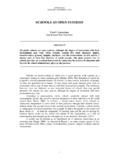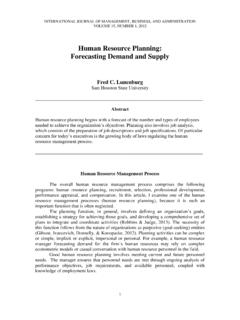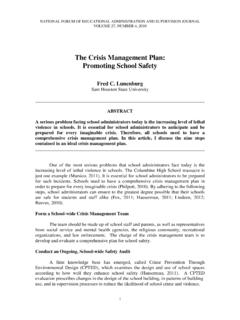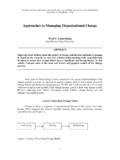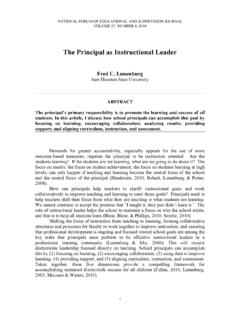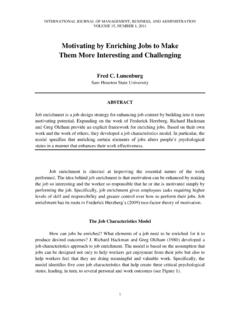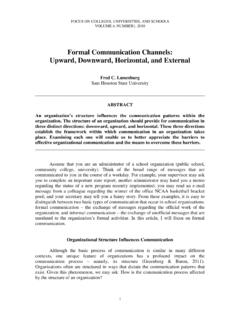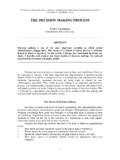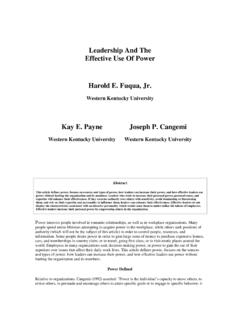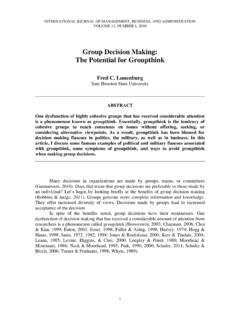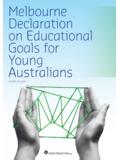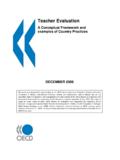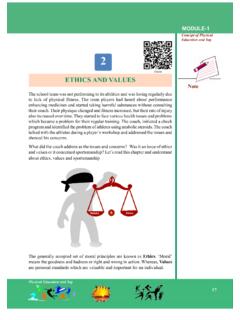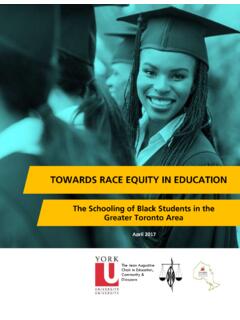Transcription of Curriculum Development: Inductive Models - National Forum
1 schooling . VOLUME 2, NUMBER 1, 2011. Curriculum Development: Inductive Models Fred C. Lunenburg Sam Houston State University _____. ABSTRACT. Three Models are presented in this article: Taba's instructional strategies model, Weinstein and Fantini's humanistic model, and Eisner's systemic-aesthetic model. Models can assist Curriculum developers to conceptualize the development process by pinpointing certain principles and procedures. The three Models examined are Inductive , nonlinear, and descriptive. Inductive Models provide a unique approach to Curriculum making as compared to the traditional deductive Models , which are linear and prescriptive. Furthermore, Inductive Models could incorporate a postmodern view of Curriculum , because they are temporal and naturalistic. You could say that the ultimate in a nonlinear, descriptive approach is the absence of a model when Curriculum makers are operating intuitively.
2 Taba's instructional strategies model is a little more theoretical than Weinstein and Fantini's humanistic approach and Eisner's systemic-aesthetic approach. _____. What is Curriculum development? What is its purpose? How does it affect students, teachers, and administrators? The way we define Curriculum development in part reflects our approach to it. Curriculum development can be defined as the process of planning, implementing, and evaluating Curriculum that ultimately results in a Curriculum plan. One way of developing a Curriculum plan is through modeling. Models are essentially patterns that serve as guidelines to action. Models can be found for almost every form of educational activity. The education profession has Models of administration, of supervision, of instruction, of evaluation, and others. There are Models of Curriculum development as well. Using a model to develop Curriculum can result in greater efficiency and productivity (Oliva, 2009).
3 By examining Models for Curriculum development, we can analyze the phases essential to the process. The three Models I have selected for analysis were conceived by well known scholars in the field: Hilda Taba (1962), Gerald Weinstein and Mario Fantini (1970), and Elliott Eisner (1991). 1. schooling . 2_____. The Models are Inductive , beginning with the development of Curriculum materials and leading to generalization. Furthermore, the Models are nonlinear. A. nonlinear approach permits Curriculum planners to enter a model at various points, skip components in the model, reverse the order, and attend to two or more components of the model simultaneously. Moreover, the three Models are descriptive. A descriptive model, referred to as naturalistic by some scholars, include three major elements: platform, deliberation, and design (Walker, (1971). By platform is meant the beliefs or principles that guide the Curriculum developers.)
4 Platform principles lead to deliberation, the process of making decisions from among alternatives. Deliberation results ultimately in a Curriculum design. Walker contrasted the naturalistic or descriptive model with the classical or prescriptive model [see Tyler (1949), Beauchamp (1981), and Saylor, Alexander, and Lewis (1981), companion article]. A descriptive model has a beginning (platform), an end (design), and a process (deliberation) through which the beginning leads to the end. The classical model (like Tyler, Beauchamp, and Saylor and associates), in contrast, is a means-end model. It assumes a desired end (goals and objectives), a means of attaining this end (learning experiences), and a process (evaluation) for determining whether the means in fact has resulted in the desired end. The two Models differ in the roles that goals and objectives and evaluation play in the Curriculum development process.
5 In the classical model, goals and objectives are essential. In the naturalistic model, goals and objectives are one means among others in the Curriculum development process. Furthermore, in the classical model, evaluation is used to determine whether learning experiences lead to the attainment of specified goals and objectives. In the naturalistic model, evaluation is used merely to justify design decisions. Taba: Instructional Strategies Model Hilda Taba (1962 reversed the commonly accepted procedure for Curriculum development by suggesting that instead of developing a general plan for the school program as the scholars in the tradition of deductive Models do, (see, Tyler, Beauchamp, and Saylor et al., companion article), it would be more profitable to begin with the planning of teaching-learning units. In such a system , teaching-learning units would provide the basis for the Curriculum design. Thus, the Curriculum would emerge from the instructional strategies.)
6 Taba developed a Grades 1 through 8 social studies Curriculum organized around teaching-learning units (Taba, 1971). In the process, a Curriculum model evolved that is applicable to many types of curricula and that can be used in many different kinds of school settings and school levels: elementary school, middle school, and high school. The model includes an organization of, and relationships among, five mutually interactive elements objectives, content, learning experiences, teaching strategies, and evaluative measures so that a system of teaching and learning is represented. The model is depicted in Figure 1. FRED C. LUNENBURG. _____3. Factors external to the model that may affect its internal components Content Learning experiences Objectives Evaluative Teaching measures strategies Factors external to the model that may affect its internal components Figure 1. Designing the Curriculum an instructional strategies approach.
7 Taba's model contains within it a number of innovative aspects: specificity in determining objectives and content; learning experiences selected and organized in accordance with specified criteria; teaching strategies that specify a variety of methods and technology; and an elaborate array of evaluative procedures and measures. Factors external to the model that may affect its internal components are also represented. Such factors include (a) the nature of the community in which the school is located its pressures, values, and resources; (b) the policies of the school district; (c) the nature of a particular school its goals, resources, and administrative strategies; (d) the personal style and characteristics of the teachers involved; and (e) the nature of the student population. Objectives help to provide a consistent focus for the Curriculum , to establish criteria for the selection of content and learning experiences, and to guide and direct evaluation of learning outcomes.
8 At the same time that objectives, content, and learning experiences are being selected and organized, teaching strategies must also be planned and developed. The process of determining objectives begins with the development of overall goals, originating from a variety of sources (for example, the demands of society, the needs of students, and the social science disciplines); is broken down into behavioral statements, classified in terms of the kinds of student outcomes expected (for example, the development of thinking skills, the acquisition, understanding and use of important elements of knowledge, and the like); and justified on the basis of a clearly thought out rationale. schooling . 4_____. The content for each grade level in the Curriculum is contained within a number of teaching-learning units, all emphasizing to some degree a yearly theme. Each unit consists of three kinds of knowledge: key concepts (for example, interdependence, cooperation, cultural change, and social control), main ideas (that is, generalizations derived from key concepts), and specific facts (that is, content samples chosen to illustrate, explain, and develop the main ideas).
9 The content contained in the units within a year's work is incorporated into learning experiences selected and organized in accordance with clearly specified criteria (for example, justifiability, transferability, variety of function, open mindedness, etc.). Care is taken to ensure that the learning experiences develop multiple objectives: thinking, attitudes, knowledge, and skills. Especially designed teaching strategies that identify specific procedures that teachers may use are included within the Curriculum . (This makes Taba's model unique.). Some have been designed to encourage students to examine their individual attitudes and values. Particularly innovative are certain strategies that promote the development of children's cognitive skills, such as comparing and contrasting, conceptualizing, generalizing, and applying previously learned relationships to new and different situations. A variety of objective format devices have been prepared to measure the effectiveness of the Curriculum in helping students to explain or recognize causal relationships, apply in new settings important generalizations developed in the Curriculum , and to interpret social science data.
10 Several open-ended devices have been designed to measure the quality of students' generalizations, the flexibility and variety of students' conceptualizations, and the variety and nature of the content that students use in response to open-ended questions. A coding scheme has been developed and used to analyze teacher-student discussions as to the levels of thinking that they exhibit, similar to Bloom and others' taxonomies (Durkin, 1993). Weinstein and Fantini: Humanistic Model Gerald Weinstein and Mario Fantini (1970) link sociopsychological factors with cognition so learners can deal with their problems and concerns. For this reason, these authors consider their model a Curriculum of affect. In viewing the model, some readers might consider it part of the behavioral, managerial, or administrative approach, but the model shifts from a deductive organization of Curriculum to an Inductive orientation from traditional content to relevant content (see Figure 2).
